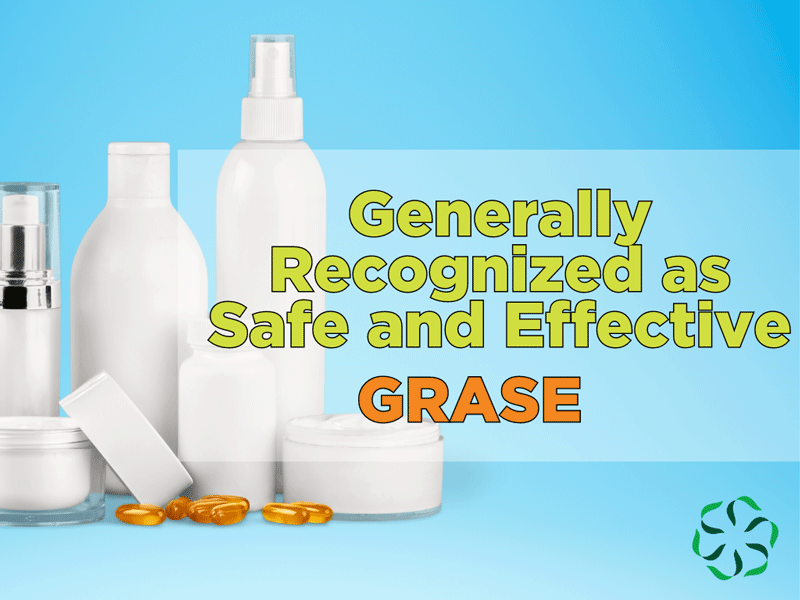In this post, we’ll look at Generally Recognized as Safe and Effective (GRASE) ingredients.
What is GRASE?
GRASE is an acronym for Generally Recognized As Safe and Effective. The U.S. Food and Drug Administration (FDA) often uses it when discussing well-established over-the-counter (OTC) drugs and ingredients added to products for therapeutic purposes.
What is a GRASE Ingredient?
There are hundreds of GRASE ingredients.
We find GRASE ingredients in many familiar products like sunscreen, pain relievers, medicated lotions, and more that contain active ingredients regulated as over-the-counter drugs like salicylic acid, camphor, calamine, zinc oxide, titanium dioxide, and many others.
Here are some everyday examples:
- Deodorant products that contain the GRASE antiperspirant ingredient potassium alum
- Lotion designed to help control acne that includes the GRASE ingredient salicylic acid
- Cosmetic makeup with sunscreen properties that have the GRASE ingredient titanium dioxide (https://www.canr.msu.edu/news/everyday-toxicology-exposure-to-ingredients-titanium-dioxide).
What makes an ingredient GRASE?
To be considered GRASE, the manufacturers must show that an over-the-counter drug product is safe and effective for its intended use through scientific evidence and/or clinical studies.
- Safety means the product does not pose an unreasonable risk when used as directed.
- Efficacy means it provides the intended therapeutic benefit.
The FDA uses monographs to evaluate the safety and efficacy of many over-the-counter ingredients.
What is a monograph?
The FDA established specific regulations and guidelines that are summarized in a document called a monograph for over-the-counter drugs.
For over-the-counter active ingredients, the monograph will include information on dosages, labeling requirements, and other standards for a particular category.
There are many monographs. A few examples include antiperspirants, sunburn prevention and treatment products, dandruff products, cold remedies, and more.
How does an ingredient become a GRASE ingredient?
Over-the-counter drugs and therapeutic ingredients need to meet the standards of and comply with monographs established by the FDA.
If an ingredient meets and complies with the protocols and standards outlined in the monograph, it’s considered GRASE.
For example, an ingredient like calamine added to a lotion would be considered GRASE if it followed the regulations outlined in the monograph for skin protectant products (1,2).
Are there concerns over GRASE ingredients?
There are many GRASE ingredients, and the FDA has panels established to help ensure over-the-counter medications remain safe and effective.
If there is evidence that an ingredient no longer meets GRASE status, then the panel may investigate to see if they should recommend an ingredient’s status changes to the FDA.
Can the status of a GRASE ingredient change?
The FDA continually works with experts to review and update the over-the-counter drug monographs to incorporate new scientific information and safety data.
Suppose the panel that advises the FDA discovers a GRASE ingredient no longer meets the safety and/or efficacy standards. In that case, they can advise that the ingredient status change and that more robust information is required before it can be deemed GRASE. Or, it may be removed from the market for that purpose altogether.
Some examples include specific sunscreen ingredients and most recently the ingredient phenylephrine found in decongestant cold medications.
What’s the difference between a GRAS and GRASE ingredient?
Generally Recognized As Safe (GRAS) ingredients differ from Generally Recognized As Safe and Effective (GRASE) ingredients.
GRAS ingredients are typically food and beverage ingredients that have been used without issue before 1958 or have undergone research showing that they are safe when consumed in normal quantities.
GRASE ingredients are typically over-the-counter therapeutic drugs and ingredients found in personal care products and medications. To remain on the market, these must meet the standards outlined in the ingredient’s specific monograph.
The good news.
While acronyms may be confusing, we know that regulatory agencies have guidelines and protocols in place to ensure personal care products advertised to improve or maintain our health remain safe and effective.
If you have any questions about foods and ingredients, please reach out to us on Twitter, send us an email, or submit your idea to us at go.msu.edu/cris-idea

